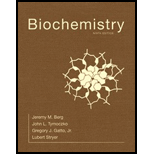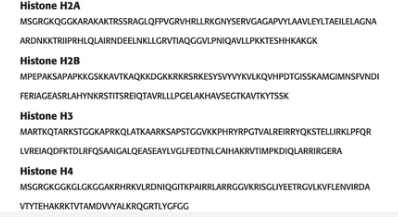
Interpretation:
The charge on histone octamer at pH 7 should be determined.
The charge on the histone should be compared with a charge on 150 bp DNA.
Concept introduction:
There are around 300 amino acids, but only 22 amino acids participate in protein synthesis. Such amino acids are termed as proteinogenic amino acids. Some amino acids are very common in protein chain, while some amino acids are rare in protein chain. The most abundant amino acids in the protein chain are leucine, serine, lysine, and glutamic acid.
Answer to Problem 1P
The charge on histone octamer at pH 7 is +146. The charge on 150 bp DNA strand is -300.
Explanation of Solution
Given information:
The histone octamer is at pH 7, and histidine neutralizes at this pH.

Histone H2A protein chain-
In histone H2A protein sequence, there are 4 charged amino acids, lysine, arginine, aspartic acid, and glutamic acid. Lysine amino acid has -NH3+ as the side chain, which ionizes at pH of 10.54. Therefore, at pH 7, this side chain of lysine will not neutralize, giving lysine residue +1 charge. There are 13 lysine residues, hence, charge on protein due to lysine is +13.
Arginine amino acid also has -NH3+ as the side chain, which ionizes at pH of 12.48. Therefore, at pH 7, this side chain of arginine will not neutralize, giving arginine residue +1 charge. There are 13 arginine residues, hence, charge on protein due to arginine is +13.
Aspartic acid has -COO- as side chain. This side chain ionizes when pH of the solution reaches to 3.86. At pH 7, -COO- will not accept the hydrogen ion, hence, the charge of aspartic acid will be -1. There are total 2 aspartate amino acids, therefore, the charge on protein due to this amino acid is -2.
Glutamic acid has -COO- as side chain. This side chain ionizes when pH of the solution reaches to 4.25. At pH 7, -COO- will not accept the hydrogen ion, hence, the charge of glutamic acid will be -1. There are total 7glutamate amino acids, therefore, the charge on protein due to this amino acid is -7.
Hence, total charge on H2A protein sequence = +13+13+ (-2) +(-7) = +17.
Histone H2B protein chain-
In histone H2B protein sequence, there are 4 charged amino acids, lysine, arginine, aspartic acid, and glutamic acid. Lysine amino acid has -NH3+ as the side chain, which ionizes at pH of 10.54. Therefore, at pH 7, this side chain of lysine will not neutralize, giving lysine residue +1 charge. There are 20 lysine residues, hence, charge on protein due to lysine is +20.
Arginine amino acid also has -NH3+ as the side chain, which ionizes at pH of 12.48. Therefore, at pH 7, this side chain of arginine will not neutralize, giving arginine residue +1 charge. There are 8 arginine residues, hence, charge on protein due to arginine is +8.
Aspartic acid has -COO- as side chain. This side chain ionizes when pH of the solution reaches to 3.86. At pH 7, -COO- will not accept the hydrogen ion, hence, the charge of aspartic acid will be -1. There are total 3 aspartate amino acids, therefore, the charge on protein due to this amino acid is -3.
Glutamic acid has -COO- as side chain. This side chain ionizes when pH of the solution reaches to 4.25. At pH 7, -COO- will not accept the hydrogen ion, hence, the charge of glutamic acid will be -1. There are total 7 glutamate amino acids, therefore, the charge on protein due to this amino acid is -7.
Hence, total charge on H2A protein sequence = +20+8+ (-3) +(-7) = +18.
Histone H3B protein chain-
In histone H3B protein sequence, there are 4 charged amino acids, lysine, arginine, aspartic acid, and glutamic acid. Lysine amino acid has -NH3+ as the side chain, which ionizes at pH of 10.54. Therefore, at pH 7, this side chain of lysine will not neutralize, giving lysine residue +1 charge. There are 13 lysine residues, hence, charge on protein due to lysine is +13.
Arginine amino acid also has -NH3+ as the side chain, which ionizes at pH of 12.48. Therefore, at pH 7, this side chain of arginine will not neutralize, giving arginine residue +1 charge. There are 18 arginine residues, hence, charge on protein due to arginine is +18.
Aspartic acid has -COO- as side chain. This side chain ionizes when pH of the solution reaches to 3.86. At pH 7, -COO- will not accept the hydrogen ion, hence, the charge of aspartic acid will be -1. There are total 4 aspartate amino acids, therefore, the charge on protein due to this amino acid is -4.
Glutamic acid has -COO- as side chain. This side chain ionizes when pH of the solution reaches to 4.25. At pH 7, -COO- will not accept the hydrogen ion, hence, the charge of glutamic acid will be -1. There are total 7 glutamate amino acids, therefore, the charge on protein due to this amino acid is -7.
Hence, total charge on H3A protein sequence = +13+18+ (-4) +(-7) = +20.
Histone H4B protein chain-
In histone H4B protein sequence, there are 4 charged amino acids, lysine, arginine, aspartic acid, and glutamic acid. Lysine amino acid has -NH3+ as the side chain, which ionizes at pH of 10.54. Therefore, at pH 7, this side chain of lysine will not neutralize, giving lysine residue +1 charge. There are 11 lysine residues, hence, charge on protein due to lysine is +11.
Arginine amino acid also has -NH3+ as the side chain, which ionizes at pH of 12.48. Therefore, at pH 7, this side chain of arginine will not neutralize, giving arginine residue +1 charge. There are 14 arginine residues, hence, charge on protein due to arginine is +14.
Aspartic acid has -COO- as side chain. This side chain ionizes when pH of the solution reaches to 3.86. At pH 7, -COO- will not accept the hydrogen ion, hence, the charge of aspartic acid will be -1. There are total 3 aspartate amino acids, therefore, the charge on protein due to this amino acid is -3.
Glutamic acid has -COO- as side chain. This side chain ionizes when pH of the solution reaches to 4.25. At pH 7, -COO- will not accept the hydrogen ion, hence, the charge of glutamic acid will be -1. There are total 4 glutamate amino acids, therefore, the charge on protein due to this amino acid is -4.
Hence, total charge on H4A protein sequence = +11+14+ (-3) +(-4) = +18.
There is a DNA with 150 bp.This means total number of bases in DNA strand are 300. Each base has -1 charge on it due to the presence of phosphate group. So, the total charge on DNA strand is -300. So, if this DNA strand binds around the above histone octamer, then half of the charges on DNA would get neutralized.
The charge on histone octamer at pH 7 is +146. The charge on 150 bp DNA strand is -300.
Want to see more full solutions like this?
Chapter 33 Solutions
Biochemistry (Looseleaf)
- You’ve isolated a protein and determined that the Native molecular weight of the holoenzyme is 160 kD using size exclusion chromatography. Analysis of this protein using SDS-PAGE revealed 2 bands, one at 100 kD and one at 30 kD. The enzyme was found to be 0.829% NAD (by weight). What further can be said regarding the structure of the polypeptide?arrow_forwardWhat is the formation of glycosylated hemoglobin (the basis for the HbA1c test)? Can you describe it?arrow_forwardPlease analze the gel electrophoresis column of the VRK1 kinase (MW: 39.71 kDa). Also use a ruler to measure the length of the column in centimeters and calculate the MW of each band observed. Lane 1: buffer Lane 2 : Ladder Lane 3: Lysate Lane 4: Flowthrough Lane 5: Wash Lanes 6-8: E1, E2, E3 Lane 9: Dialyzed VRK1 Lane 10: LDHarrow_forward
- Do sensory neurons express ACE2 or only neurolipin-1 receptors for COVID19 virus particle binding?arrow_forwardExplain the process of CNS infiltration of COVID19 through sensory neurons from beginning to end, including processes like endocytosis, the different receptors/proteins that are involved, how they are transported and released, etc.,arrow_forwardH2C CH2 HC-COOO CH2 ܘHO-C-13c-O isocitrate C-S-COA H213c CH2 C-OO 13C-S-COA CH2 C-00 the label will not be present in succinyl CoA C-S-COA succinyl-CoAarrow_forward
- A culture of kidneys cells contains all intermediates of the citric acid cycle. It is treated with an irreversible inhibitor of malate dehydrogenase, and then infused withglucose. Fill in the following list to account for the number of energy molecules that are formed from that one molecule of glucose in this situation. (NTP = nucleotidetriphosphate, e.g., ATP or GTP)Net number of NTP:Net number of NADH:Net number of FADH2:arrow_forward16. Which one of the compounds below is the final product of the reaction sequence shown here? OH A B NaOH Zn/Hg aldol condensation heat aq. HCI acetone C 0 D Earrow_forward2. Which one of the following alkenes undergoes the least exothermic hydrogenation upon treatment with H₂/Pd? A B C D Earrow_forward
- 6. What is the IUPAC name of the following compound? A) (Z)-3,5,6-trimethyl-3,5-heptadiene B) (E)-2,3,5-trimethyl-1,4-heptadiene C) (E)-5-ethyl-2,3-dimethyl-1,5-hexadiene D) (Z)-5-ethyl-2,3-dimethyl-1,5-hexadiene E) (Z)-2,3,5-trimethyl-1,4-heptadienearrow_forwardConsider the reaction shown. CH2OH Ex. CH2 -OH CH2- Dihydroxyacetone phosphate glyceraldehyde 3-phosphate The standard free-energy change (AG) for this reaction is 7.53 kJ mol-¹. Calculate the free-energy change (AG) for this reaction at 298 K when [dihydroxyacetone phosphate] = 0.100 M and [glyceraldehyde 3-phosphate] = 0.00300 M. AG= kJ mol-1arrow_forwardIf the pH of gastric juice is 1.6, what is the amount of energy (AG) required for the transport of hydrogen ions from a cell (internal pH of 7.4) into the stomach lumen? Assume that the membrane potential across this membrane is -70.0 mV and the temperature is 37 °C. AG= kJ mol-1arrow_forward
 BiochemistryBiochemistryISBN:9781305577206Author:Reginald H. Garrett, Charles M. GrishamPublisher:Cengage Learning
BiochemistryBiochemistryISBN:9781305577206Author:Reginald H. Garrett, Charles M. GrishamPublisher:Cengage Learning Biology (MindTap Course List)BiologyISBN:9781337392938Author:Eldra Solomon, Charles Martin, Diana W. Martin, Linda R. BergPublisher:Cengage Learning
Biology (MindTap Course List)BiologyISBN:9781337392938Author:Eldra Solomon, Charles Martin, Diana W. Martin, Linda R. BergPublisher:Cengage Learning BiochemistryBiochemistryISBN:9781305961135Author:Mary K. Campbell, Shawn O. Farrell, Owen M. McDougalPublisher:Cengage Learning
BiochemistryBiochemistryISBN:9781305961135Author:Mary K. Campbell, Shawn O. Farrell, Owen M. McDougalPublisher:Cengage Learning Biology: The Unity and Diversity of Life (MindTap...BiologyISBN:9781305073951Author:Cecie Starr, Ralph Taggart, Christine Evers, Lisa StarrPublisher:Cengage Learning
Biology: The Unity and Diversity of Life (MindTap...BiologyISBN:9781305073951Author:Cecie Starr, Ralph Taggart, Christine Evers, Lisa StarrPublisher:Cengage Learning Biology 2eBiologyISBN:9781947172517Author:Matthew Douglas, Jung Choi, Mary Ann ClarkPublisher:OpenStax
Biology 2eBiologyISBN:9781947172517Author:Matthew Douglas, Jung Choi, Mary Ann ClarkPublisher:OpenStax




